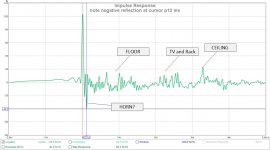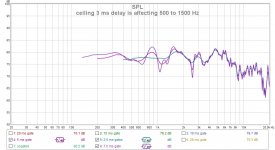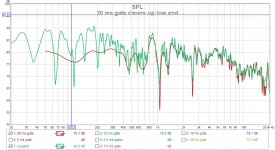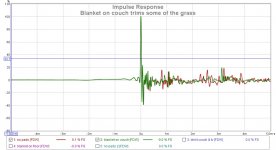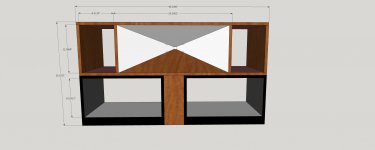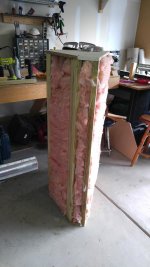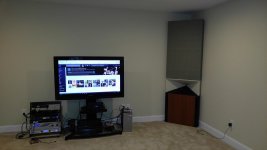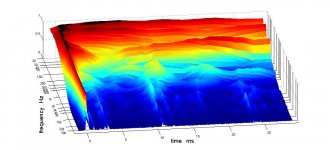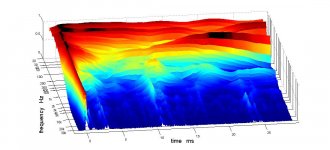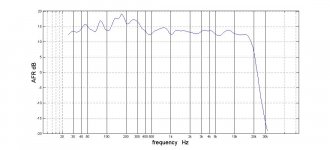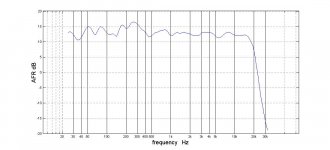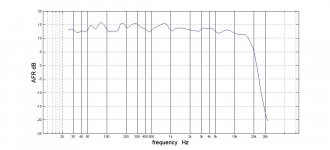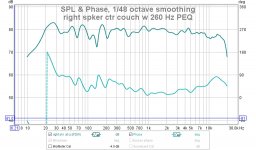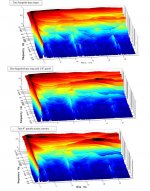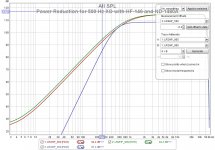Identifying reflections
Between TDA, IR, gated sweeps, and geometry, I think I have the reflections pinned down.
The IR shows the close in stuff best:
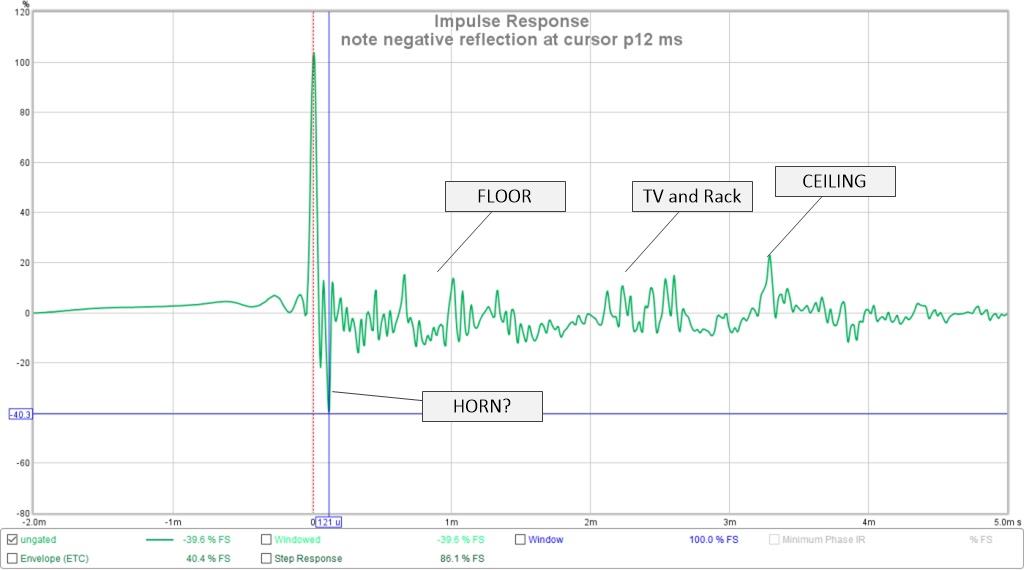
The measurements I'll show next are all without any FDW but with various gates. I'm comparing responses with different gates to see when reflections arrive.
The nastiness around 1 Khz seems to be due to the ceiling, which comes in at about 3 ms delay. With a 2.5 ms gate, circa 1 Khz is nice and smooth.
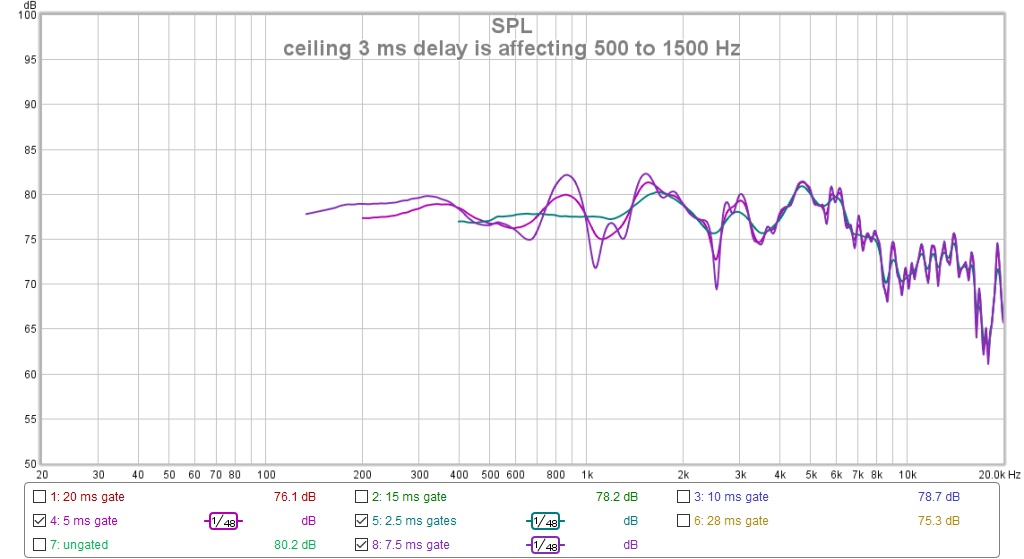
Similarly, a 20 ms gate cleans up the low end, except for that broad dip centered at 105 Hz. Edit I no longer think the dip there is due to the ceiling. SBIR says predicts a ceiling null at 140 hz which we see in the ungated
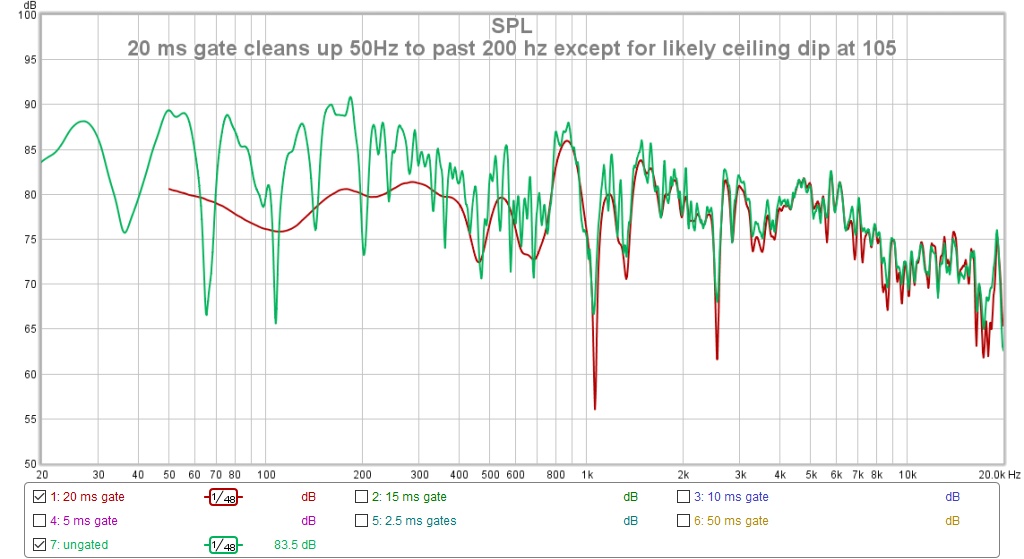
The easiest thing for me to do is add more bass damping by building corner bass traps that match the footprints of my horns and extend almost to the ceiling, filling them with pink fluffy fiberglass. This should give me twice the absorption of those 4" panels I've got across the corners now and frees up those panels for use elsewhere. More floor absorption and ceiling panels aren't in the immediate future.
Between TDA, IR, gated sweeps, and geometry, I think I have the reflections pinned down.
The IR shows the close in stuff best:
The measurements I'll show next are all without any FDW but with various gates. I'm comparing responses with different gates to see when reflections arrive.
The nastiness around 1 Khz seems to be due to the ceiling, which comes in at about 3 ms delay. With a 2.5 ms gate, circa 1 Khz is nice and smooth.
Similarly, a 20 ms gate cleans up the low end, except for that broad dip centered at 105 Hz. Edit I no longer think the dip there is due to the ceiling. SBIR says predicts a ceiling null at 140 hz which we see in the ungated
The easiest thing for me to do is add more bass damping by building corner bass traps that match the footprints of my horns and extend almost to the ceiling, filling them with pink fluffy fiberglass. This should give me twice the absorption of those 4" panels I've got across the corners now and frees up those panels for use elsewhere. More floor absorption and ceiling panels aren't in the immediate future.
Attachments
Last edited:
Well, some activity, not sure it qualifies as progress.
I haven't felt like work on room treatments so I've been listening as is, which isn't a hardship, and doing other things.
One of the things that discouraged me from treating the room was doing some measurements with a think blanket over my listening couch. It turns out that while the couch may be good for damping the bass it is anything but that for higher frequencies.
This picture overlays IRs taken at the center couch LP with/without the blanket on the couch.
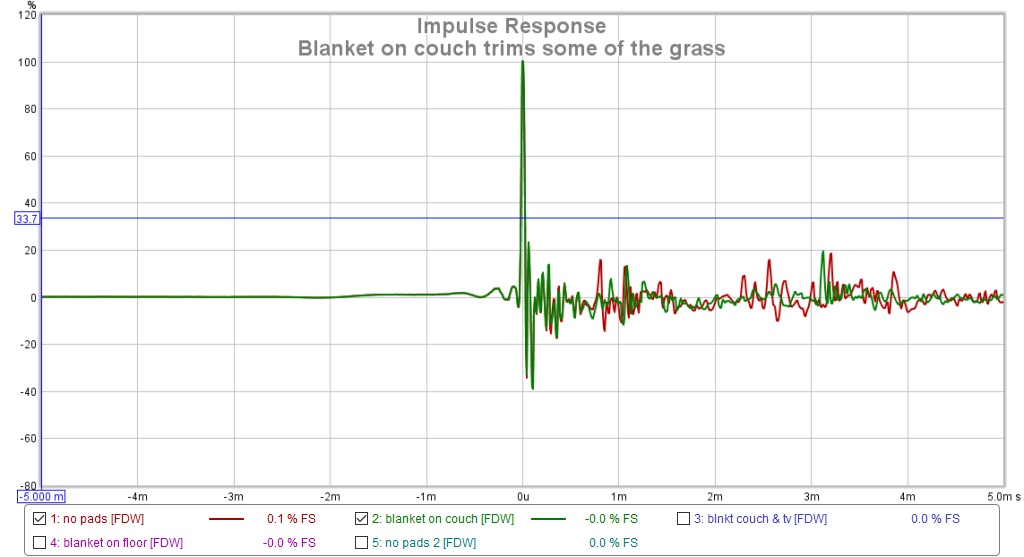
About half of those early reflections are off the couch. We just bought it a couple of years ago. One thing in my favor though is my wife hates it.
I haven't felt like work on room treatments so I've been listening as is, which isn't a hardship, and doing other things.
One of the things that discouraged me from treating the room was doing some measurements with a think blanket over my listening couch. It turns out that while the couch may be good for damping the bass it is anything but that for higher frequencies.
This picture overlays IRs taken at the center couch LP with/without the blanket on the couch.
About half of those early reflections are off the couch. We just bought it a couple of years ago. One thing in my favor though is my wife hates it.
Attachments
I've been not only listening to music but also watching some movies. In the movies I kept turning up the volume to make the dialog clearer but, since I'm using phantom center, the background sound goes up with it. Then along comes an action scene and the dead are awoken. I'm sure there is a way to control the volume of a phantom center. I doubt it is something I can implement easily with the equipment that I have. So I've been working on a center channel design.
I'll just post a concept dwg now. Its the same horn but repackaged 48" wide so that a fairly large TV can sit on top of it. The design includes 8RU or rack space as well as some half rack space. The mids are 8FE200's vented to a 60 Hz tune but high passed at 80 Hz.
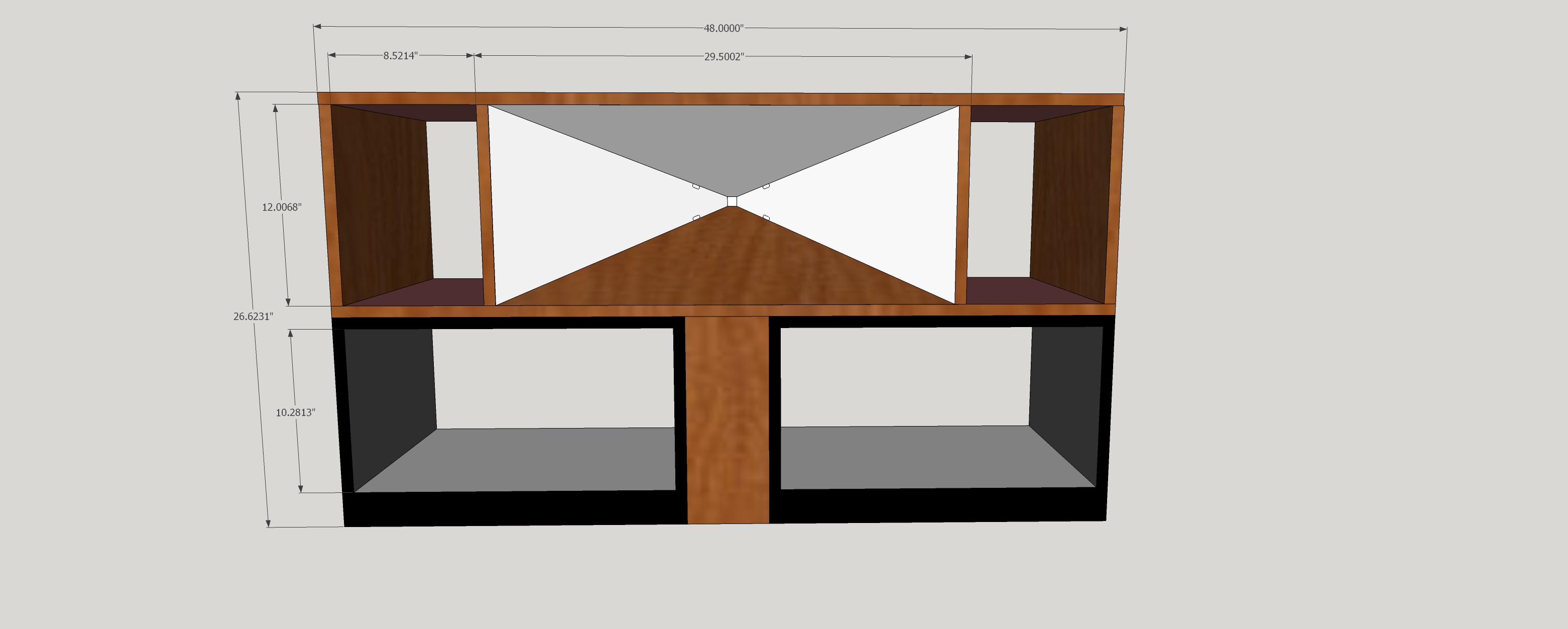
I'll just post a concept dwg now. Its the same horn but repackaged 48" wide so that a fairly large TV can sit on top of it. The design includes 8RU or rack space as well as some half rack space. The mids are 8FE200's vented to a 60 Hz tune but high passed at 80 Hz.
Attachments
I had a burst of energy and built a bass trip to sit on top of the horn, maximizing absorber volume. This should have almost 2x the absorption of the 4" of 703 panels I have across the horn corners now. Unfortunately, I only had enough material on hand for one of them.
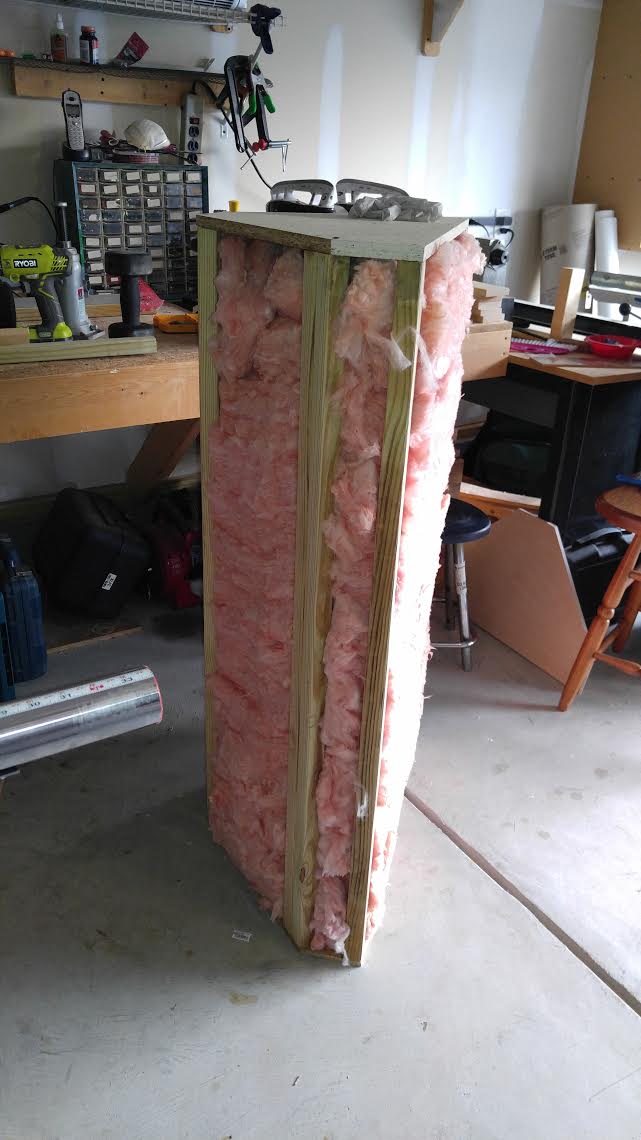
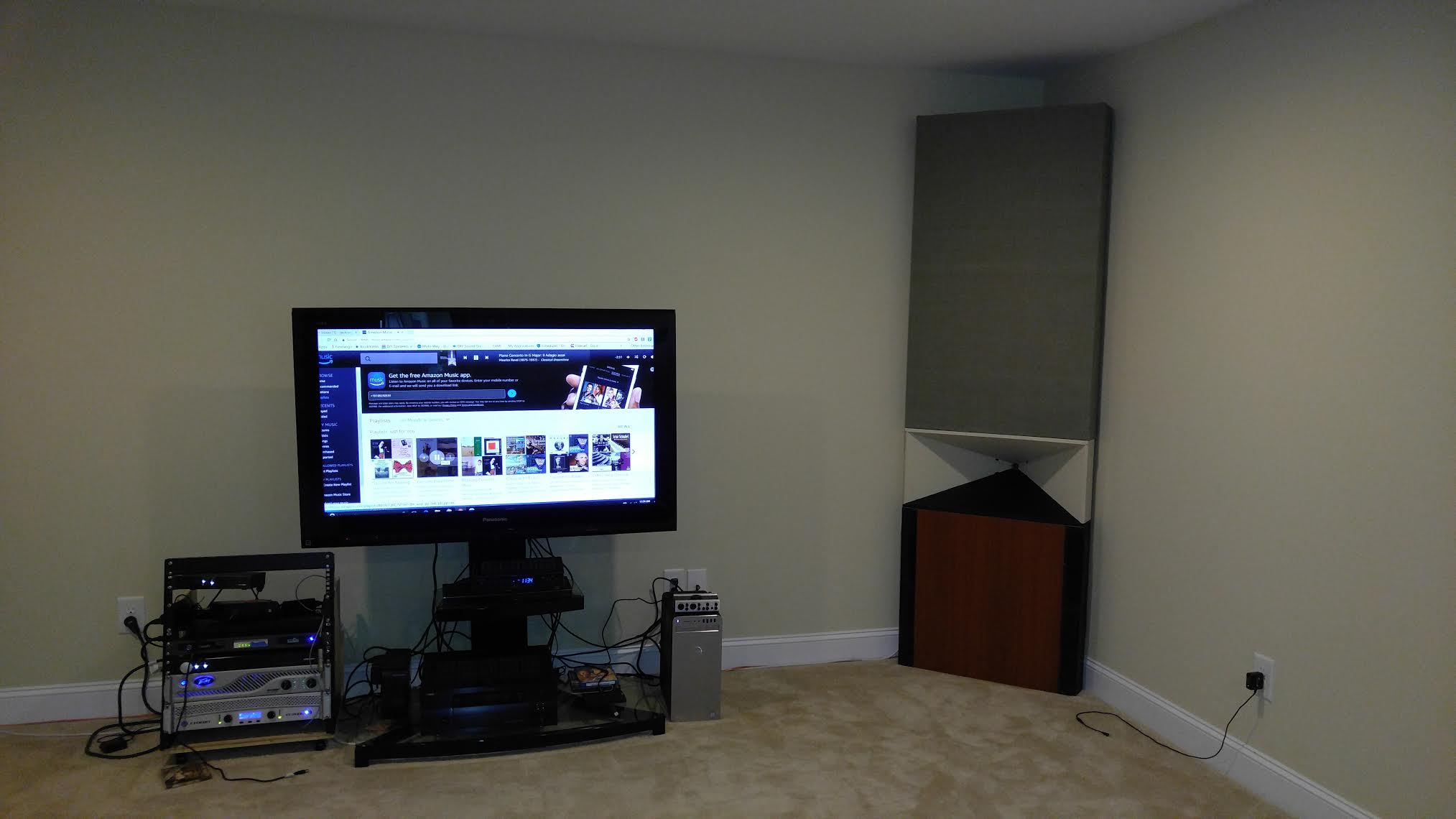
I'll post before and after measurements shortly
I'll post before and after measurements shortly
Attachments
Here is tda 3d "before"
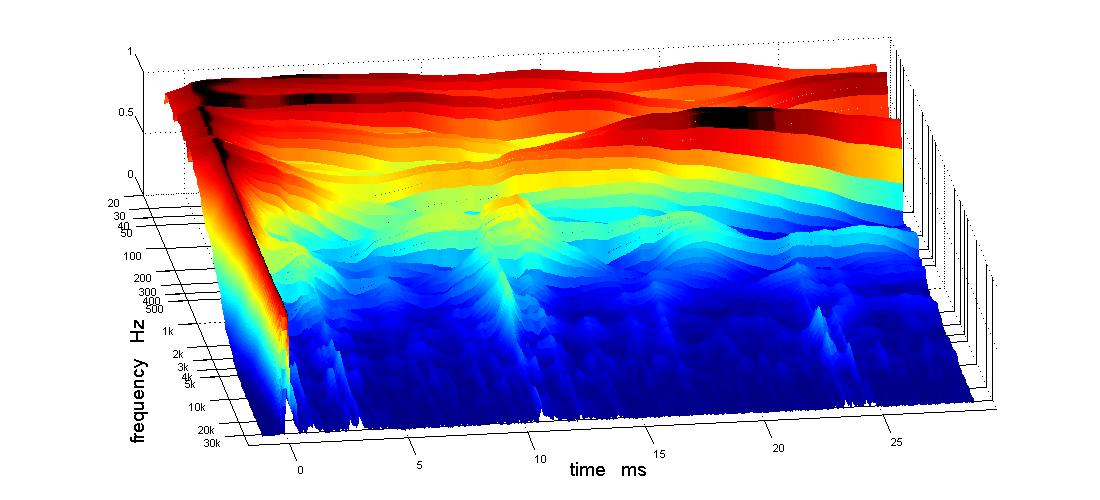
and after, with the freed up 4" panel now in a back corner
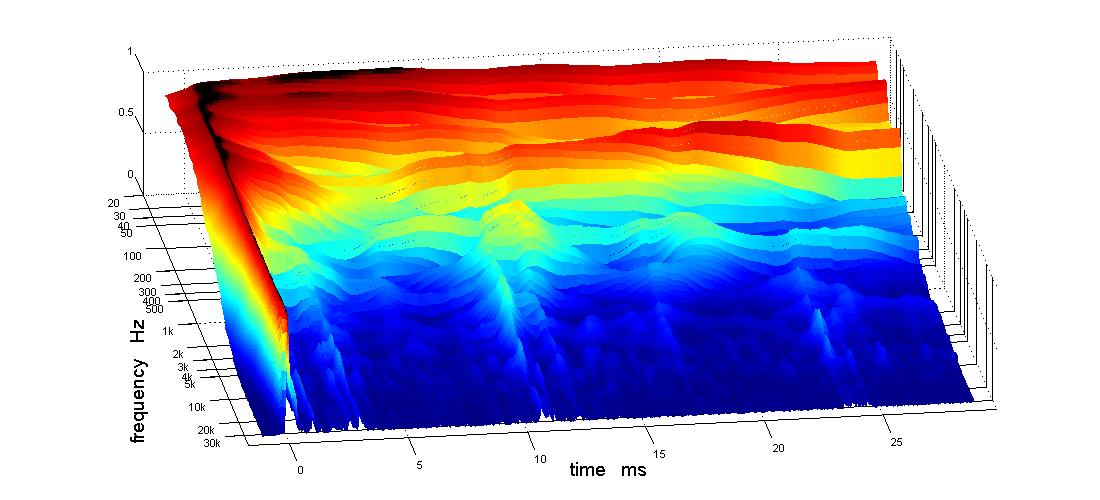
the level of the circa 200 Hz resonance is knocked down noticeably
Here is the AFR before
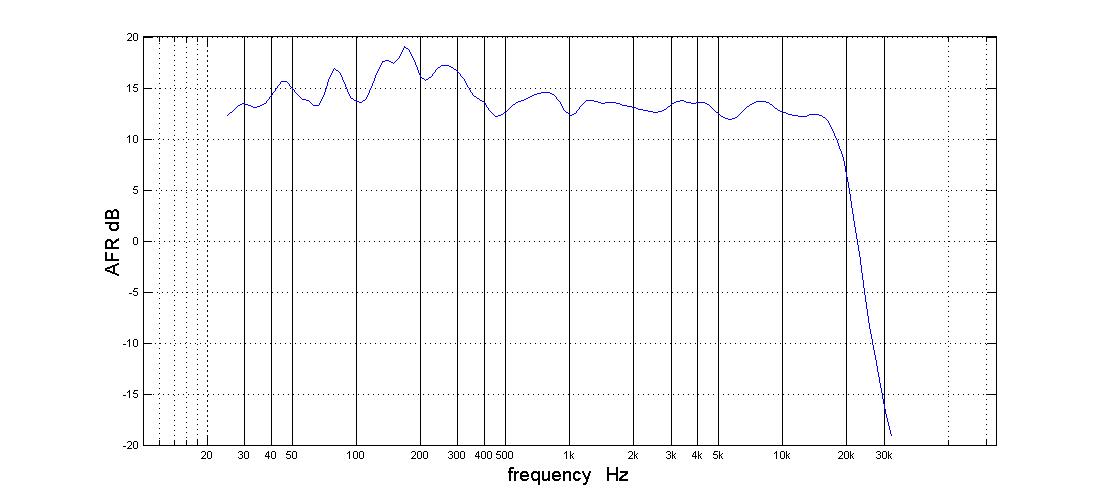
and the AFR after
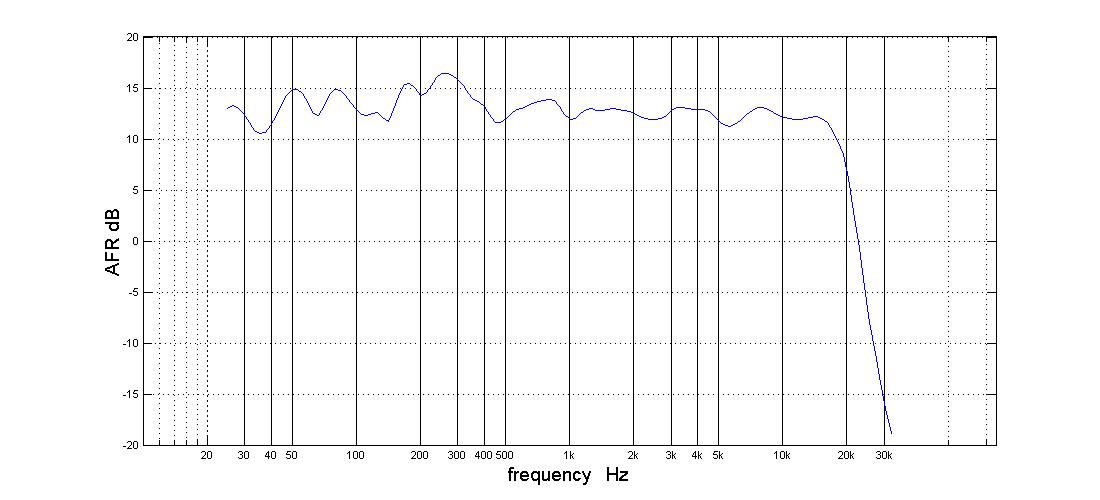
In the AFR's I see changes in the 150-300 Hz region.
and after, with the freed up 4" panel now in a back corner
the level of the circa 200 Hz resonance is knocked down noticeably
Here is the AFR before
and the AFR after
In the AFR's I see changes in the 150-300 Hz region.
Attachments
With the room attenuated that little bit I felt emboldened to try a little "room eq" - to knock down that peak around 260 Hz. It took just a minute or two using the TDA AFR as a guide to add a 260 Hz, -4db PEQ with Q=4 to the OpenDRC. This is the AFR with that PEQ in place
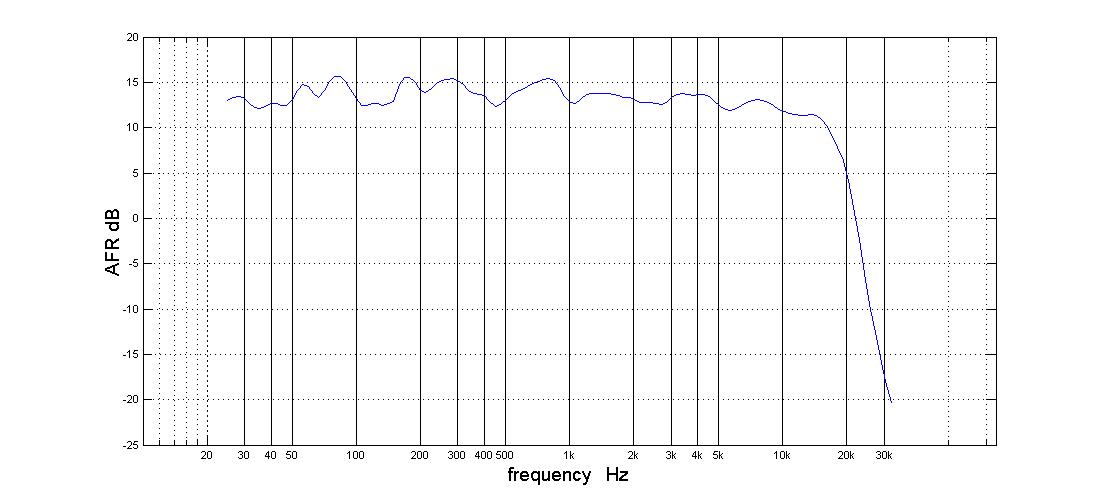
That is the magnitude response of the direct wave as perceived by TDA. It includes the near reflections that we hear so is a good guide for EQ. Its not the same as what REW sees, 5 cycle FDW:
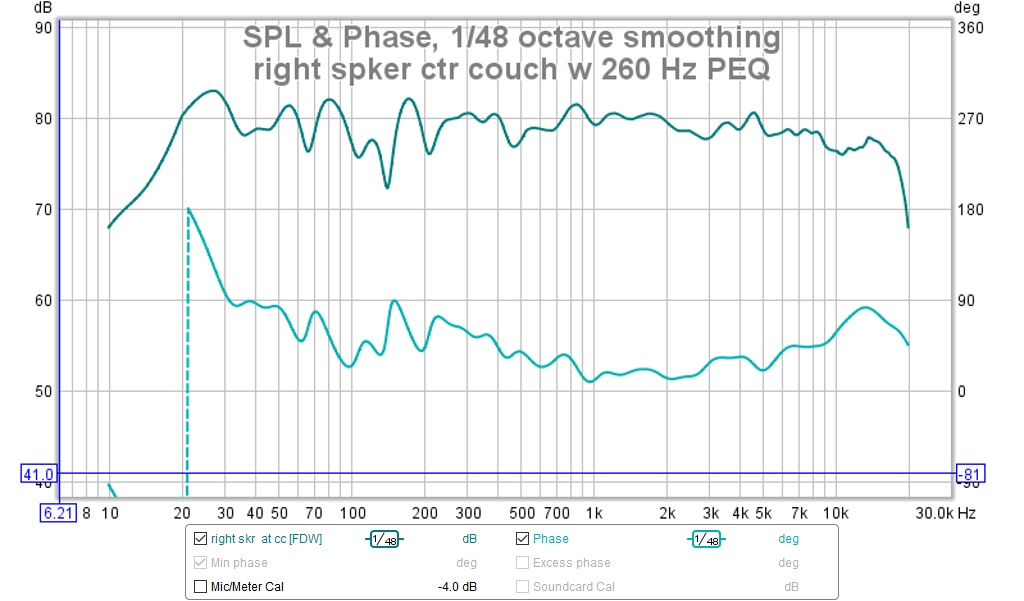
This seemed worth listening to and that is what I did for much of the rest of the day - it was delightful; more so than before - but perhaps that is just me liking my speakers.
That is the magnitude response of the direct wave as perceived by TDA. It includes the near reflections that we hear so is a good guide for EQ. Its not the same as what REW sees, 5 cycle FDW:
This seemed worth listening to and that is what I did for much of the rest of the day - it was delightful; more so than before - but perhaps that is just me liking my speakers.
Attachments
I completed a 2nd horn footprint shaped bass trap. Here you can see the incremental improvement from the initial pair of 4" 703 panels across the corner to the larger bass traps.
The measurements look good, do you notice much difference when listening?
Some, not dramatic but that 200-300 Hz region is flattened and I think I can hear that.
What I need to do is re-equalize; see if I dare do more EQ at the LP given that I've reduced the influence of the room there.
I should have mentioned those TDA plots are at the LP
What I need to do is re-equalize; see if I dare do more EQ at the LP given that I've reduced the influence of the room there.
I should have mentioned those TDA plots are at the LP
May I give you a tip? Get rid of that almost square bend at low frequencies (black line)
Instead make it more like a gradual bend. This is felt more than can be heard but it will make your foot tap on more songs. It will feel more natural.
Linear phase seems the objective but not all songs will sound better. If it's a more flowing bend, giving up perfection in the bottom octaves it will bring in line the queues you feel with the sounds you hear.
Just a tip, try it once. See if you like it. 🙂 Look at the 2D APL plot and make it a gradual bend starting at where the FR curve starts to drop (basically let phase follow minimum phase on the bottom end).
The damping fixed more than the ~200 Hz area, even lower the plot starts to look better too.
Edit the tonal balance to your liking by simple broad stroke EQ and it will sound wonderful.
Instead make it more like a gradual bend. This is felt more than can be heard but it will make your foot tap on more songs. It will feel more natural.
Linear phase seems the objective but not all songs will sound better. If it's a more flowing bend, giving up perfection in the bottom octaves it will bring in line the queues you feel with the sounds you hear.
Just a tip, try it once. See if you like it. 🙂 Look at the 2D APL plot and make it a gradual bend starting at where the FR curve starts to drop (basically let phase follow minimum phase on the bottom end).
The damping fixed more than the ~200 Hz area, even lower the plot starts to look better too.
Edit the tonal balance to your liking by simple broad stroke EQ and it will sound wonderful.
Last edited:
May I give you a tip? Get rid of that almost square bend at low frequencies (black line)
Instead make it more like a gradual bend. This is felt more than can be heard but it will make your foot tap on more songs. It will feel more natural.
Linear phase seems the objective but not all songs will sound better. If it's a more flowing bend, giving up perfection in the bottom octaves it will bring in line the queues you feel with the sounds you hear.
Just a tip, try it once. See if you like it. 🙂 Look at the 2D APL plot and make it a gradual bend starting at where the FR curve starts to drop (basically let phase follow minimum phase on the bottom end).
The damping fixed more than the ~200 Hz area, even lower the plot starts to look better too.
Edit the tonal balance to your liking by simple broad stroke EQ and it will sound wonderful.
I've been wanting to do that. I had that foot tapping feel before I did the phase correction FIR and didn't realize I was missing it until far enough down the road that I was reluctant to go back. Yesterday I got some of it back by using the equalizer in my player to boost the bass -enough to know what I was missing. Now that I've made some progress on the room I've got more reason to take that step back and then hopefully two steps forward.
My steps forward involve a new workstation/media PC and JRiver. Figuring out that path has consumed a lot of time. To complicate matters, for some no doubt strange reason, the APL software doesn't want to run on it.
It would be nice to buy something like a Motu 16A and do all the filtering in JR. Then I could do linear phase XO instead of the phase corrected IIR XO whose time alignment is so delicate. But that is too large a step to take all at once. So I will keep the miniDSPs and APL1 for that at least for now. But I will be able to do global eq in JR and/or the sound card, which is more convenient.
No real progress on my center channel speaker other than several partially completed competing designs.
I've decided that my center channel speaker will use a 1.4" CD and be a 2-way reaching down to 40 Hz or so. I have the two questions re' the CD: which one and how low dare I cross it over. The Faital Pro HF-14x series of CDs have gotten good reviews and I've heard of them being used in home environments crossed over at 500 Hz. The ND-1480A from 18Sound looks good on paper. I would prefer an answer from the data sheet as regards the minimum XO.
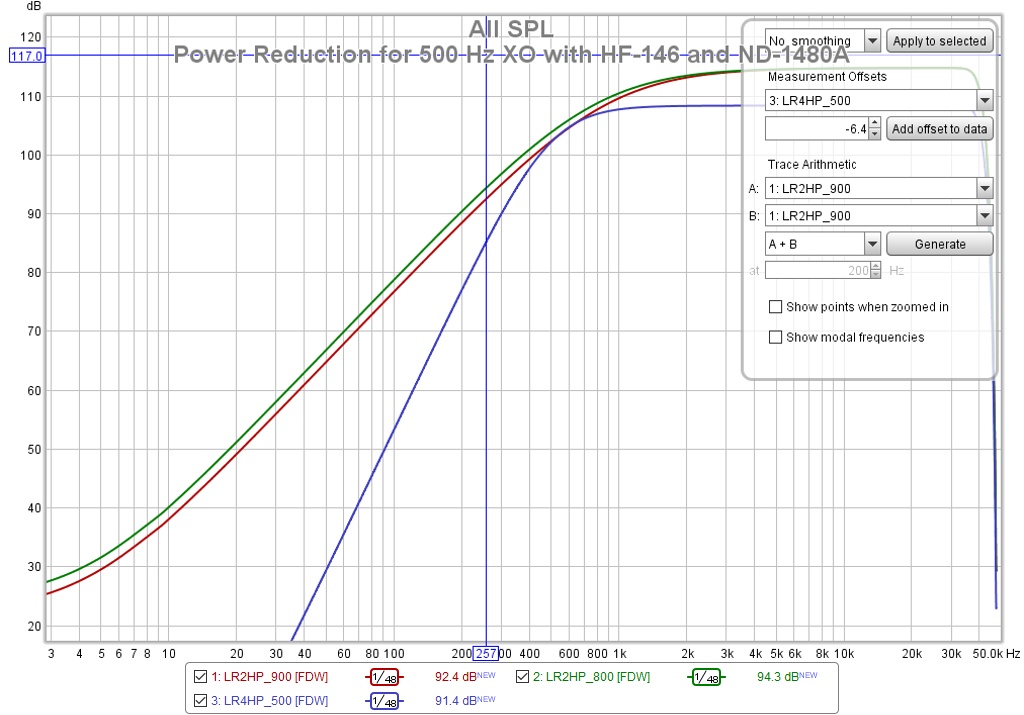
Above, I've plotted a 12 db/octave roll off curve for the HF-146 from its 900 Hz minimum recommended crossover and also from 800 Hz for the 18Sound ND1480A. On the same graph there is a 500 Hz high pass curve with a 24 db slope. Clearly, no more power is input to the HF-146 at any frequency with a 500 Hz XO if the max power is reduced by 6.4 db from the specified maximum. The 500 Hz XO demands less excursion from the CD below XO because of its steeper slope.
The required power reduction for the ND-1480A is 5.4 db. With these reductions the HF-146 can reach 121.6 db at its maximum AES power rating and the ND-1480A can reach 124.6 db on whatever horns they were measured on for the data sheet. Unfortunately, the ND-1480A lists at around $500 and I don't know where to buy it in the US. The HF-146 is readily available at ~$250.
This little analysis identifies a safe power limit for a 500 Hz XO. By remaining well below that power limit, I hope and expect they will also sound good.
I've decided that my center channel speaker will use a 1.4" CD and be a 2-way reaching down to 40 Hz or so. I have the two questions re' the CD: which one and how low dare I cross it over. The Faital Pro HF-14x series of CDs have gotten good reviews and I've heard of them being used in home environments crossed over at 500 Hz. The ND-1480A from 18Sound looks good on paper. I would prefer an answer from the data sheet as regards the minimum XO.
Above, I've plotted a 12 db/octave roll off curve for the HF-146 from its 900 Hz minimum recommended crossover and also from 800 Hz for the 18Sound ND1480A. On the same graph there is a 500 Hz high pass curve with a 24 db slope. Clearly, no more power is input to the HF-146 at any frequency with a 500 Hz XO if the max power is reduced by 6.4 db from the specified maximum. The 500 Hz XO demands less excursion from the CD below XO because of its steeper slope.
The required power reduction for the ND-1480A is 5.4 db. With these reductions the HF-146 can reach 121.6 db at its maximum AES power rating and the ND-1480A can reach 124.6 db on whatever horns they were measured on for the data sheet. Unfortunately, the ND-1480A lists at around $500 and I don't know where to buy it in the US. The HF-146 is readily available at ~$250.
This little analysis identifies a safe power limit for a 500 Hz XO. By remaining well below that power limit, I hope and expect they will also sound good.
Attachments
I am struggling, reading this thread, there are so much interesting! Ticking many boxes I like 🙂
Half-way through at the moment.
Half-way through at the moment.
Here is a thread where an ND1460A has been used in a waveguide with a 700 Hz crossover, measurements look good.
http://www.htguide.com/forum/showthread.php?35812-The-Raptor-a-10-quot-MTM&highlight=xt1464
P.Audio do a 1.4" version of the 2" compression driver that is re-badged as a Klipsch K69 or something like that. I think the 2" is what Chris is using in his K402 Synergy.
http://www.paudiothailand.com/uploads/pdf/products/BM-D740.pdf
http://www.htguide.com/forum/showthread.php?35812-The-Raptor-a-10-quot-MTM&highlight=xt1464
P.Audio do a 1.4" version of the 2" compression driver that is re-badged as a Klipsch K69 or something like that. I think the 2" is what Chris is using in his K402 Synergy.
http://www.paudiothailand.com/uploads/pdf/products/BM-D740.pdf
Hi Fluid:
Thanks for those links ... and congrats on your line arrays. I only recently stumbled across your thread; don't generally look in the full range forum.
Breakup comes pretty early in the 1460a. The 1480A is much better.
The BM-D740 looks too smooth to be true in the high end for a titanium driver. There is an unsmoothed measurement at
P.Audio BMD740 - P.Audio BMD740 1.4" high frequency compression driver. P.Audio speaker components available at US Speaker.
but you can't beat the price.
I thought Chris was using TADs with 1.4" to 2" adapters. Likely he has both.
Thanks for those links ... and congrats on your line arrays. I only recently stumbled across your thread; don't generally look in the full range forum.
Breakup comes pretty early in the 1460a. The 1480A is much better.
The BM-D740 looks too smooth to be true in the high end for a titanium driver. There is an unsmoothed measurement at
P.Audio BMD740 - P.Audio BMD740 1.4" high frequency compression driver. P.Audio speaker components available at US Speaker.
but you can't beat the price.
I thought Chris was using TADs with 1.4" to 2" adapters. Likely he has both.
Thanks, the line arrays are quite different to most of the stuff in the full range forum!Hi Fluid:
Thanks for those links ... and congrats on your line arrays. I only recently stumbled across your thread; don't generally look in the full range forum.
It was more the low crossover he had used that I thought might be useful information.Breakup comes pretty early in the 1460a. The 1480A is much better.
The datasheet has definitely had a lot of smoothing, The US Speaker image looks like an old driver too so hard to know what the real response is. Probably more like the un-smoothed one though 😉The BM-D740 looks too smooth to be true in the high end for a titanium driver. There is an unsmoothed measurement at
P.Audio BMD740 - P.Audio BMD740 1.4" high frequency compression driver. P.Audio speaker components available at US Speaker.
but you can't beat the price.
From reading his thread on the Klipsch forum I think he has the TAD's in the Main speakers and was using the standard K69 in the Centre Channel which is the one he synergized.I thought Chris was using TADs with 1.4" to 2" adapters. Likely he has both.
When you look at the Faital response curves remember they have been measured on a tractrix horn that beams a bit more at the high end boosting the on axis response over what you would get on a conical. The Eighteensound horns are more like a conical in their response.
I don't like the breakup I see in the larger titanium diaphragms.
Reminding myself, the 1480A is an aluminum dome with a polyester suspension. Its breakup is not that great either. THe 1480N has a titanium nitride coated dome and has much better breakup but its rated for only 1.2 Khz XO and doesn't look suitable for a 500 Hz XO. The HF-146 has a ketone polymer diaphragm and, if I can believe the data sheet, very well controlled breakup.
Going back to fluid's last point, which is a good one. The HF-146 data sheet shows the FR is relatively flat to 12 khz and then down 10 db at 18 khz. On a constant directivity horn link a conical, expect another 6 db per octave starting at 3 or 4 khz. So it might need 22 db of boost to be flat to 18 khz. A house curve would provide some relief. Even so, that might be too much. I see the Faital Titanium diaphragm drivers don't have this rolloff. Maybe I need to consider them
Reminding myself, the 1480A is an aluminum dome with a polyester suspension. Its breakup is not that great either. THe 1480N has a titanium nitride coated dome and has much better breakup but its rated for only 1.2 Khz XO and doesn't look suitable for a 500 Hz XO. The HF-146 has a ketone polymer diaphragm and, if I can believe the data sheet, very well controlled breakup.
Going back to fluid's last point, which is a good one. The HF-146 data sheet shows the FR is relatively flat to 12 khz and then down 10 db at 18 khz. On a constant directivity horn link a conical, expect another 6 db per octave starting at 3 or 4 khz. So it might need 22 db of boost to be flat to 18 khz. A house curve would provide some relief. Even so, that might be too much. I see the Faital Titanium diaphragm drivers don't have this rolloff. Maybe I need to consider them
Hi nc535 and fluid,
Is blank myself into CD area but if 15kHz reach is enough remember xrk971 had insane high SPL and impressive low distortion using small pro cone driver in tractrix horn useable from 300Hz http://www.diyaudio.com/forums/full-range/259293-prv-5mr450-ndy-fast-applications.html#post3994608
Is blank myself into CD area but if 15kHz reach is enough remember xrk971 had insane high SPL and impressive low distortion using small pro cone driver in tractrix horn useable from 300Hz http://www.diyaudio.com/forums/full-range/259293-prv-5mr450-ndy-fast-applications.html#post3994608
Hi nc535 and fluid,
Is blank myself into CD area but if 15kHz reach is enough remember xrk971 had insane high SPL and impressive low distortion using small pro cone driver in tractrix horn useable from 300Hz http://www.diyaudio.com/forums/full-range/259293-prv-5mr450-ndy-fast-applications.html#post3994608
Is 15 kHz enough? well I can still hear 16 kHz 🙂
My BMS-4550's have a breakup peak at 18 kHz that I flatten in the XO. On some of these 1.4" CDs, the breakup isn't so well controlled that a simple PEQ can minimize its effects.
Fluid's point about tractrix vs constant directivity horns applies here. Put that 3" full range driver on a constant directivity horn, and due to spreading the sound around the room instead of concentrating it on axis at HF, there will no longer be enough SPL at HF.
And if you look at that full range driver's FR, you will see breakup there also.
- Home
- Loudspeakers
- Multi-Way
- My Synergy Corner Horn and Bass Bins
